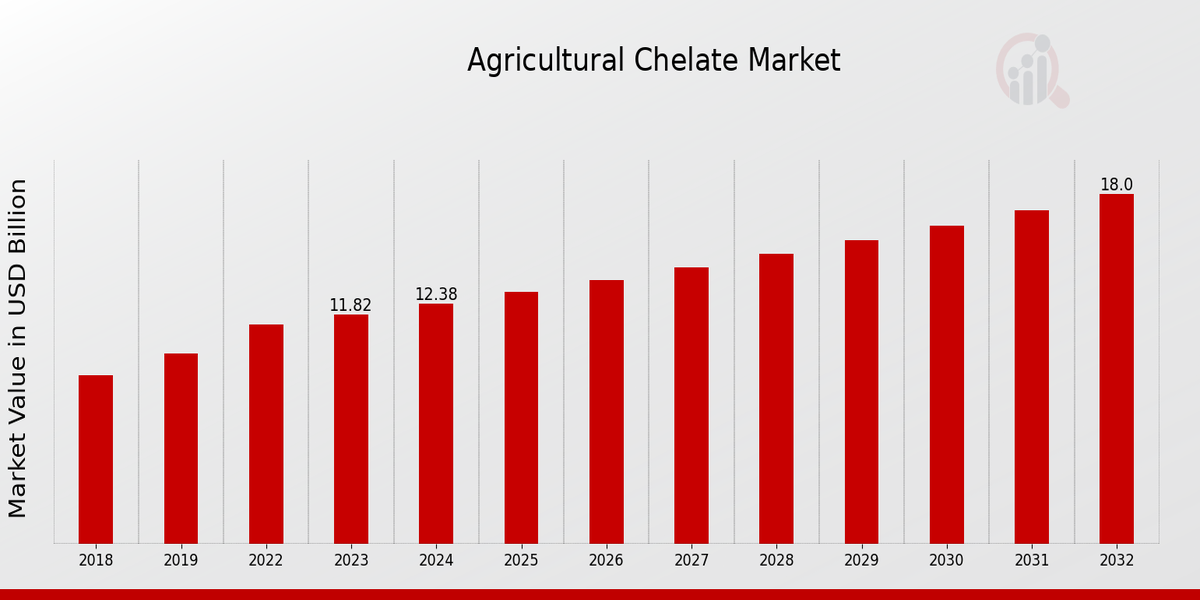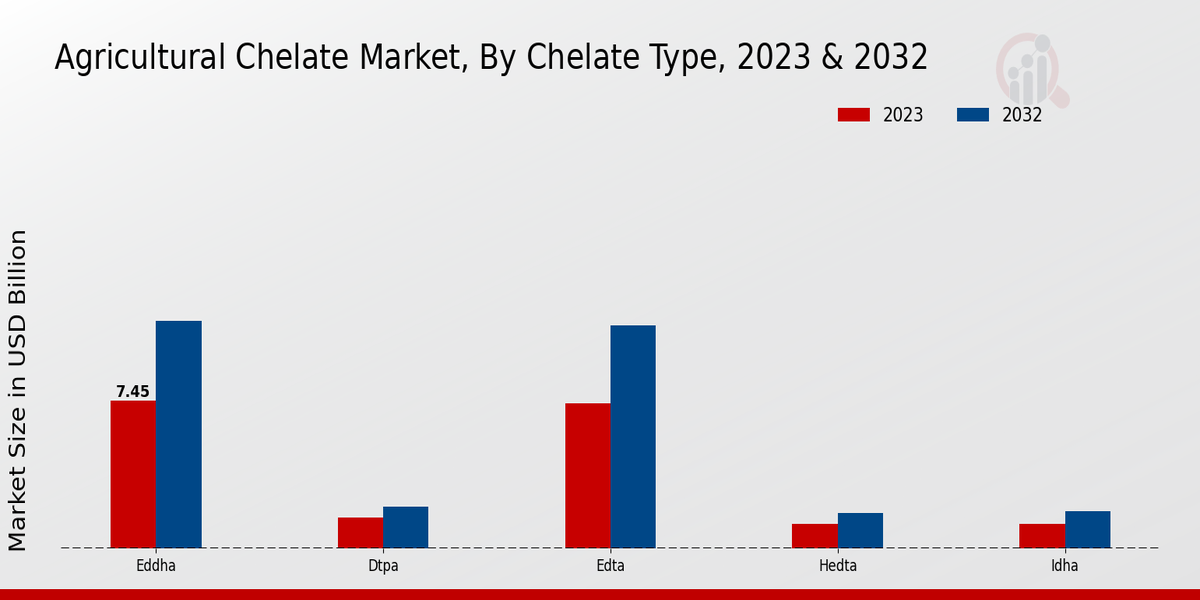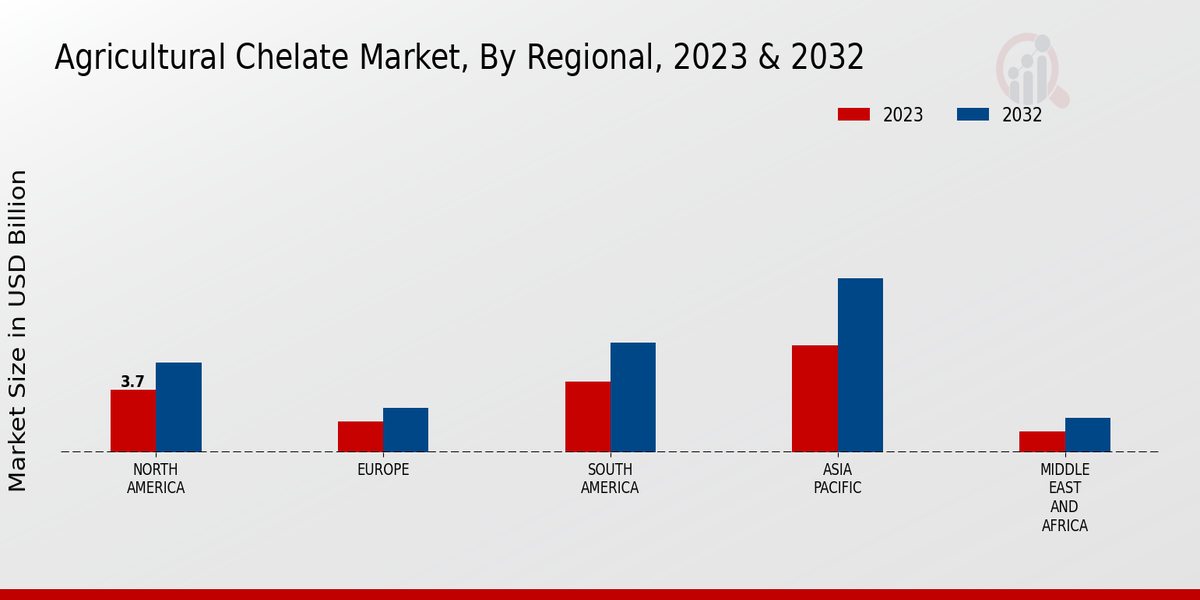Global Agricultural Chelate Market Overview
Agricultural Chelate Market Size was estimated at 11.28 (USD Billion) in 2022.The Agricultural Chelate Market Industry is expected to grow from 11.82(USD Billion) in 2023 to 18.0 (USD Billion) by 2032. The Agricultural Chelate Market CAGR (growth rate) is expected to be around 4.79% during the forecast period (2024 - 2032).

Source: Primary Research, Secondary Research, MRFR Database and Analyst Review
Key Agricultural Chelate Market Trends Highlighted
The growth in the usage of agricultural chelates has mainly been due to the need to boost the quantity and quality of crop production in a sustainable way. This has the capacity to improve plant growth and resistance to nutrient deficiency diseases since the plants are able to better and efficiently uptake the chelated micronutrients. Even more, the growing consciousness of the importance of conserving soils away from erosion has made people shift to the use of chelated fertilizers, which reduce the loss of nutrients to leaching and degradation of soils.
Some of the new potentials in the agricultural chelate market are the chelation materials made from bio-based agents. These sustainable chelates are expected to be delivered such that they will not compromise the environment. Also, the market for chelates is increasing due to the rising demand for precision agriculture technologies, such as the variable rate application that requires custom-made formulation of soils for particular crops and conditions.
Current developments in the agricultural chelate market comprise a particularly evolving crop towards the control of environmentally harmful chelates, with a shift towards sustainability. The market is also seeing more activity in research and development on how to improve the performance of the existing chelates and introduce new ones that are specially designed to work with certain crops or soil types. In addition, the incorporation of digital tools such as data analytics and remote sensing has facilitated the accurate and appropriate use of chelates based on the present crop and soil status.
Agricultural Chelate Market Drivers
Rising Demand for High-Value Crops
The rising population and growing disposable incomes are creating a demand for high-value crops such as fruits, vegetables, and nuts. These crops have a specific requirement for an array of essential nutrients, and chelating agents are instrumental in achieving this. Chelates not only facilitate the delivery of the required nutrients to a growing plant but also help in promoting better uptake and utilization of the same. Thus, when used in high-value crops, these agents can facilitate better crop quality, yield, and, most notably, enhanced nutritional profile.
This is expected to offer lucrative growth opportunities to the Agricultural Chelate Market Industry during the course of the forecast period.
Increasing Adoption of Precision Farming Techniques
Precision farming involves the use of technology to optimize crop production and reduce environmental impact. It involves collecting data on soil conditions, crop health, and weather patterns to make informed decisions about nutrient management. Chelates are an integral part of precision farming as they allow for targeted nutrient application, reducing waste and maximizing nutrient efficiency. The adoption of precision farming techniques is expected to drive the demand for chelates in the Agricultural Chelate Market Industry.
Government Regulations and Environmental Concerns
Governments worldwide are implementing stricter regulations to minimize the environmental impact of agricultural practices. The use of chelates can help reduce nutrient runoff and leaching, which can contaminate water bodies and harm aquatic ecosystems. Chelates also promote plant nutrient uptake, reducing the need for excessive fertilizer application, which can contribute to greenhouse gas emissions. The growing emphasis on sustainable agriculture is expected to drive the demand for chelates in the Agricultural Chelate Market Industry.
Agricultural Chelate Market Segment Insights:
Agricultural Chelate Market Chelate Type Insights
The Agricultural Chelate Market is segmented by chelate type into EDDHA, DTPA, EDTA, HEDTA, and IDHA. Of these, EDDHA held the largest market share in 2023, and the segment is projected to continue its dominance throughout the forecast period. The dominance is mainly due to the high stability of EDDHA and its effectiveness in chelating micronutrients, more particularly, iron in calcareous soils. EDDHA forms stable complexes with iron and does not allow soil particles to immobilize it, in turn, making it available to plants. Another key chelate type in the Agricultural Chelate Market is DTPA, which is majorly used in acidic and neutral soils to chelate micronutrients like iron, zinc, and manganese.
Factually, DTPA is relatively less stable, but more effective to be used in soils having below 7.0 pH levels. EDTA is a universal chelating agent that can be used in various soil conditions, and more commonly, it is used to chelate iron, zinc, and copper. Because of being less stable, EDTA lacks the effectiveness and most other chelate agents, but still it is more soluble and that is they it can be applied using foliar sprays. HEDTA is another chelate type, which is also most effective in chelating iron in neutral and alkaline soils. This one is most frequently used in hydroponics or in high alkaline pH soils.
IDHA is a synthetic chelate type, which is constructed specifically for iron deficiencies in plants, and it is also highly stable and thus powerful to be used with high-value crops. The Agricultural Chelate Market is anticipated to grow during the forecast period for decades due to the growing demand for micronutrient chelates and rising awareness among farmers across the world.

Source: Primary Research, Secondary Research, MRFR Database and Analyst Review
Agricultural Chelate Market Crop Type Insights
Introduction Crop type is the most prominent segmentation application for the market covered by the forecast under consideration. As such, the agricultural chelate market is segmented into Cereals and Grains, Fruits and Vegetables, Oilseeds and Pulses, and Turf and Ornamentals, among others. Cereals and Grains dominated the market share in 2023, amounting to over 45% of the revenue. Cereals such as rice, wheat, and corn are widely cultivated across the globe and are used as staple foods for the human population, requiring the use of chelates.
Fruits and Vegetables are expected to have the greatest CAGR of 5.2% for the next seven years. The growth of this segment can be attributed to the soaring demand for high-quality and nutrition-rich produces and the increased application of chelates to bolster plant health and crop production. Oilseeds and Pulses, including soybean, canola, and peas, will also remain pertinent to the sector amid the expanding interest in sustainable agriculture and the use of protein-rich food. The final segment, Turf and Ornamentals, is restricted to the likes of lawns, golf courses, and ornamental plants but serves to drive the market growth for a CAGR of 5.1%.
Agricultural Chelate Market Application Method Insights
The Application Method segment of the Agricultural Chelate Market is categorized into Foliar Spraying, Soil Application, Fertigation, and Seed Treatment. Foliar Spraying dominates the market with a significant market share, owing to its effectiveness in delivering nutrients directly to plant leaves, resulting in improved nutrient uptake and crop yield. Soil Application holds a substantial market share, as it involves applying chelates directly to the soil, ensuring nutrient availability to plant roots. Fertigation is gaining traction, as it combines fertigation and irrigation, allowing for precise nutrient delivery through irrigation systems.
Seed Treatment, though a niche segment, offers advantages such as improved seed germination, seedling vigor, and early crop establishment, contributing to its growth potential. The Agricultural Chelate Market segmentation provides insights into the performance of different application methods, enabling stakeholders to make informed decisions and capitalize on emerging opportunities.
Agricultural Chelate Market End User Insights
The Agricultural Chelate Market segmentation by End User into Commercial Farmers, Hobby Farmers, Greenhouses and Nurseries provides valuable insights into the market dynamics. Commercial Farmers are expected to dominate the market, accounting for a significant revenue share in 2023. The increasing demand for higher crop yield and quality drives the segment growth. Hobby Farmers are estimated to hold a notable market share, driven by the rising trend of urban farming and gardening. Greenhouses and Nurseries are projected to witness substantial growth due to the controlled environment and precise nutrient delivery methods employed in these settings.
The Agricultural Chelate Market's segmentation analysis offers comprehensive data and statistics that help stakeholders make informed decisions and capitalize on growth opportunities.
Agricultural Chelate Market Form Insights
By form, the market has been segmented into liquid, granular, and powder. Among these, the liquid segment held the largest market share in 2023. This can be attributed to the ease of application and higher nutrient uptake efficiency of liquid chelates. The granular segment is expected to witness the fastest growth over the forecast period due to its cost-effectiveness and ease of handling. The powder segment is also expected to grow at a steady pace, primarily driven by its use in fertigation systems.
Agricultural Chelate Market Regional Insights
Regionally, North America held the largest share of the market in 2023, accounting for over 35% of the revenue. The region's dominance can be attributed to the presence of major agricultural producers, such as the United States and Canada, which have a high adoption rate of chelates in crop production. Europe is the second-largest market for agricultural chelates, with a significant share of over 25%. The region has a strong focus on sustainable agriculture and precision farming, which is driving the demand for chelates. APAC is expected to be the fastest-growing regional market for agricultural chelates, with a CAGR of over 6% during the forecast period.
The region's growing population and increasing agricultural production are contributing to the demand for chelates. South America and MEA are also expected to witness steady growth in the agricultural chelates market, driven by factors such as increasing crop production and government initiatives to promote sustainable agriculture.

Source: Primary Research, Secondary Research, MRFR Database and Analyst Review
Agricultural Chelate Market Key Players And Competitive Insights:
Major players in the Agricultural Chelate Market industry are focusing on expanding their presence, developing new products, and forming strategic alliances to gain a competitive edge. Leading Agricultural Chelate Market players are investing in research and development to improve the efficiency and sustainability of their products. The development of the agricultural cheat market is being driven by the increasing demand for high-quality agricultural products, the need to improve crop yields, and the growing awareness of the environmental benefits of chelates. The Agricultural Chelate Market Competitive Landscape is expected to remain highly competitive, with a number of key players vying for market share.
BASF is a leading supplier of agricultural chelates. The company offers a wide range of chelates, including EDTA, DTPA, and EDDHA. BASF's chelates are used in a variety of applications, including foliar feeding, soil application, and hydroponics. The company has a strong presence in the Americas, Europe, and Asia Pacific.
Koch Industries is another major player in the Agricultural Chelate Market. The company offers a variety of chelates, including EDTA, DTPA, and EDDHA. Koch Industries' chelates are used in a variety of applications, including foliar feeding, soil application, and hydroponics. The company has a strong presence in the Americas, Europe, and Asia Pacific.
Key Companies in the Agricultural Chelate Market Include:
-
Tracka Pty
-
Compass Minerals International
-
Valagro
-
Haifa Group
-
Albemarle Corporation
-
Marrone Bio Innovations
-
Verdesian Lifesciences
-
Arxada plc
-
Yara International
-
Haisheng Chemical Industry
-
Clariant
-
Gujarat State Fertilizers Chemicals
-
BASF SE
-
Kothari International
Agricultural Chelate Market Industry Developments
The agricultural chelate market is projected to grow from an estimated USD 11.82 billion in 2023 to USD 18.0 billion by 2032, at a CAGR of 4.79%. This growth is attributed to increasing demand for high-quality crops, rising awareness about the benefits of chelates in plant nutrition, and government initiatives to promote sustainable agriculture practices. Recent developments in the market include the launch of new chelate products with enhanced nutrient absorption capabilities and the expansion of production facilities by key players to meet growing demand. Furthermore, strategic collaborations and acquisitions are shaping the market landscape, with companies seeking to strengthen their market position and expand their product offerings.
Agricultural Chelate Market Segmentation Insights
Agricultural Chelate Market Chelate Type Outlook
EDDHA
DTPA
EDTA
HEDTA
IDHA
Agricultural Chelate Market Crop Type Outlook
Cereals and Grains
Fruits and Vegetables
Oilseeds and Pulses
Turf and Ornamentals
Agricultural Chelate Market Application Method Outlook
Foliar Spraying
Soil Application
Fertigation
Seed Treatment
Agricultural Chelate Market End User Outlook
Commercial Farmers
Hobby Farmers
Greenhouses and Nurseries
Agricultural Chelate Market Form Outlook
Liquid
Granular
Powder
Agricultural Chelate Market Regional Outlook
North America
Europe
South America
Asia Pacific
Middle East and Africa
| Report Attribute/Metric |
Details |
| Market Size 2022 |
11.28(USD Billion) |
| Market Size 2023 |
11.82(USD Billion) |
| Market Size 2032 |
18.0(USD Billion) |
| Compound Annual Growth Rate (CAGR) |
4.79% (2024 - 2032) |
| Report Coverage |
Revenue Forecast, Competitive Landscape, Growth Factors, and Trends |
| Base Year |
2023 |
| Market Forecast Period |
2024 - 2032 |
| Historical Data |
2019 - 2023 |
| Market Forecast Units |
USD Billion |
| Key Companies Profiled |
Tracka Pty, Compass Minerals International, Valagro, Haifa Group, Albemarle Corporation, Marrone Bio Innovations, Verdesian Lifesciences, Arxada plc, Yara International, Haisheng Chemical Industry, Clariant, Gujarat State Fertilizers Chemicals, BASF SE, Kothari International |
| Segments Covered |
Chelate Type, Crop Type, Application Method, End User, Form, Regional |
| Key Market Opportunities |
Increasing crop yields Growing demand for high-quality produce Rising urbanization and dietary changes Technological advancements Favorable government regulations |
| Key Market Dynamics |
Increasing crop yields Soil health improvement Rising environmental concerns Government initiatives Technological advancements |
| Countries Covered |
North America, Europe, APAC, South America, MEA |
Frequently Asked Questions (FAQ) :
The Agricultural Chelate Market is anticipated to be worth around USD 11.82 billion in 2023.
The Agricultural Chelate Market is projected to grow at a CAGR of 4.79% from 2024 to 2032.
The Agricultural Chelate Market is expected to reach approximately USD 18.0 billion by 2032.
The North America region is expected to account for the largest market share in the Agricultural Chelate Market during the forecast period.
Agricultural chelates are primarily used in the production of fertilizers, animal feed, and micronutrient supplements.
Some of the key competitors in the Agricultural Chelate Market include BASF, Dow, FMC Corporation, and Compass Minerals.
Rising demand for fertilizers, increasing awareness of the importance of micronutrients, and government initiatives to promote sustainable agriculture are driving the growth of the Agricultural Chelate Market.
Fluctuating raw material prices, stringent environmental regulations, and intense competition are some of the challenges faced by the Agricultural Chelate Market.
Growing demand for organic fertilizers, increasing adoption of precision agriculture, and expansion into emerging markets present opportunities for growth in the Agricultural Chelate Market.
Sustainability, innovation, and digitalization are key trends shaping the Agricultural Chelate Market.

















